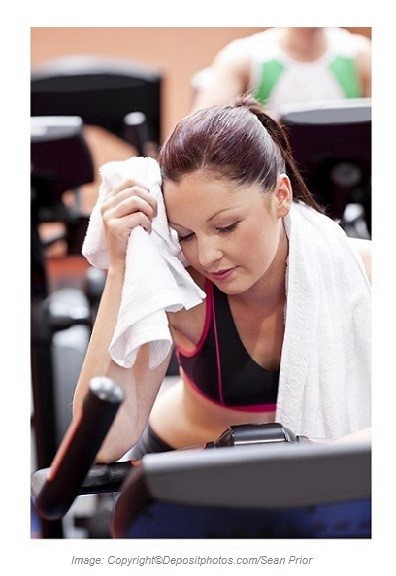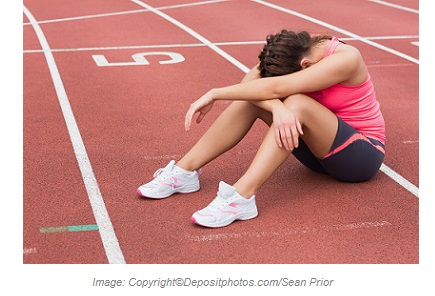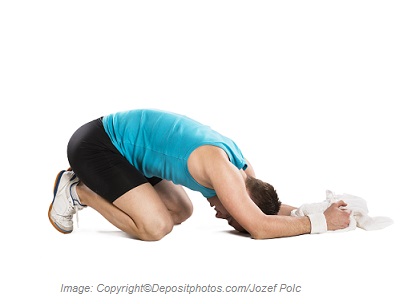Affecting up to 30% of athletes of team sports and 50% of athletes of individual sports  and gym-goers, overtraining syndrome (OTS) is a complex syndrome with physical, psychological, emotional, immunological, and biochemical changes. Known also as burnout, overworked, overstressed, and staleness, OTS results from excessive training overload and inadequate recovery.
and gym-goers, overtraining syndrome (OTS) is a complex syndrome with physical, psychological, emotional, immunological, and biochemical changes. Known also as burnout, overworked, overstressed, and staleness, OTS results from excessive training overload and inadequate recovery.
Criteria for OTS are:
- Amassing of training and non-training stresses.
- Presence of a constellation of physiological and psychological signs and symptoms.
- Impaired athletic performance and decreased training capacity for more than 2 weeks.
- Necessity of recovering and restoring for weeks or months.
Overreaching is a short-term decrease in athletic performance in training and competition resulted from excessive training overload or non-training stresses without adequate recovery with or without related signs and symptoms. A successful recovery can be achieved within 2 weeks. Untreated overreaching eventually causes long-term decrement in athletic performance and training capacity, which is called “overtraining syndrome”.
Clinical Forms of OTS:
Practically, OTS has been categorized into two forms:
- Sympathetic overtraining.
- Parasympathetic overtraining.
Sympathetic Overtraining:
Known also as “basedowian form” or “hyperactive thyroid type “, sympathetic overtraining is characterized by increased sympathetic activity at rest, irritability, restlessness, sleep disturbance, and impaired athletic performance. This form of OTS is mainly related to anaerobic exercise, such as resistance training.
Parasympathetic Overtraining:
Parasympathetic overtraining is famous as “addisonoid form” or “adrenal exhaustion type” as well. It is characterized by hyperactivity of parasympathetic (vagal) system at rest and during exercise. Signs and symptoms include chronic fatigue during exercise, mood swings, loss of interest in training or competition, sleep disturbance, weak immune system, changes in appetite, tendency to infections, and poor athletic performance. This form of OTS is usually related to aerobic activities, such as long distance exercise.
General Signs and Symptoms of OTS:
OTS may cause the following signs and symptoms: 
- Psychological and emotional:
- Depressed moods.
- Loss of interest in training.
- Loss of motivation.
- Emotional instability.
- Poor concentration.
- Loss of competitive drive.
- Sleep disturbance.
- Increased skipping or missing trainings.
- Endocrinological:
- Chronic fatigue.
- Amenorrhea.
- Negative nitrogen balance.
- Delayed menstruation.
- Increased cortisol level.
- Increased blood urea nitrogen.
- Low levels of DHEA and testosterone.
- Decreased zinc and selenium levels.
- Hypothalamic dysfunction.
- Immunological:
- Increased risk of infections.
- Frequent mild flu – like illnesses.
- Weakened immune system.
- Physical:
- Decreased athletic performance.
- Prolonged recovery.
- Altered blood pressure.
- Increased heart and breathing rates.
- Increased resting metabolic rate.
- Hematological:
- Low level of iron.
- Low level of hemoglobin.
- Enlarged lymph nodes.
- Decreased white blood cells.
- Gastrointestinal:
- Loss of appetite.
- Nausea.
- Stomach upset.
- Neuromuscular:
- Loss of coordination.
- Decreased muscle strength.
- Increased muscle soreness.
- Rhabdomyolysis (exercise – induced muscle damage). See “Post – Exercise Rhabdomyolysis” under the section of “Athletic Disorders”.
- Decreased muscle glycogen.
- Increased risk of sports injuries.
Management of OTS:
The following general advices help with OTS: 
- Rest.
- Stop training for at least 2 weeks.
- Avoid prolonged training sessions (over 100 minutes per session).
- Avoid training for 7 days a week.
- Reduce intensity and volume of training.
- Use periodization.
- Deep tissue massage.
Nutritional Supports to Manage or Prevent OTS:
- Water: drink 2 – 3 liters a day and keep the body fully hydrated.
- Have sufficient complex carbohydrate before training (see “Nutrition Before Exercise” under the section of “Sports Nutrition”).
- Adequate protein intake: keep your daily protein intake at 2 grams/kg.
- Have about 40 grams protein within 30 minutes after training and another 40 grams in 2 hours.
- Glutamine: 5 – 10 grams about 40 – 60 minutes before training and another 5 grams at bedtime. This amino acid helps with recovery and glycogen replenishment.
- Vitamin C: 2 – 3 grams a day.
- Vitamin E: 400 – 800 IU a day.
- Vitamin B5: 200 – 400 mg a day.
- Zinc: 50 – 100 mg a day. This mineral is depleted from the body during stress and intense exercise. It also supports the immune function.
- BCAA (branched-chain amino acid): 3 grams 30 minutes before training, 3 grams during training, and 5 grams within 30 minutes after training.
- HMB: (beta-Hydroxy beta-Methylbutyrate): 3000 – 4000 mg daily in divided doses. The best time to take HMB is approximately 30 minutes before exercise or competition and immediately after exercise within anabolic window. It has a protective effect against OTS.
- Glutathione: 200 – 500 mg a day. It is a powerful antioxidant that may prevent from OTS.
- ALA (alpha-lipoic acid): 800 – 1000 mg a day. ALA may prevent from athletic overtraining syndrome by enhancing glutathione level within the muscles.
- French Maritime Pine Bark Extract: 200 – 300 mg a day. It is a potent antioxidant that supports the immune system.
- Octacosanol: 2000 – 5000 mcg a day. It is a fatty alcohol with a protective activity against OTS.
- Adaptogens: take two of them as per your choice and availability (see “Adaptogens” under the section of “Supplementation”).
- A high – quality Multivitamins-Multiminerals.

